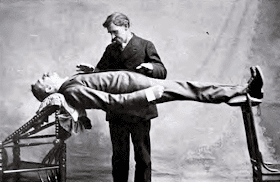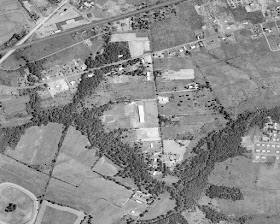"Bob! Your heart!"
Silence.
"Bob! Your heart! Your heart is beating!"
The eyelids did not flutter. There was no breath.
"Bob, your heart action is beginning. It is beginning."
Davenport bent lower still as the county coroner and other physicians looked on approvingly. Almost whispering now, "Oh I say, Bob, look, your heart is beginning to beat."
What is this? A scene out of a Vincent Price thriller, or maybe something you saw once on the late late late show?
None of the above. This scene took place on November 9, 1909, in the "dead room" of Somerset Hospital in Somerville. Amateur hypnotist William E. Davenport of Newark had been summoned by "Professor" Arthur Everton to try to revive the rigid body of Robert Simpson. This request came from Everton's jail cell.
 |
| Robert Simpson and Professor Arthur Everton on stage in Somerville |
Everton first placed Simpson in a hypnotic trance. But rather than command Simpson through a comedic skit of some sort, he induced in Simpson a rigid cataleptic state and suspended him horizontally between two chairs.
Just as they had performed countless times before, Everton climbed up and stood for a few moments on Simpson's chest. The subject remained motionless, unable to hear the audience applause that swept through the theater. Everton removed the chairs, stood Simpson up, and attempted to summon him from the trance.
Just as Simpson should have been waking up, he collapsed violently to the ground. A visibly shaken Everton dragged Simpson into the wings and worked feverishly to revive his friend. Only a few minutes later he called to the audience for a doctor.
Simpson was immediately pronounced dead at the scene by Dr. W. H. Long, the county physician, who happened to be in the audience that evening - but Professor Everton pleaded with the medical men, stating that he believed Simpson was still in a trance and could be revived if he had time to work on him.
Long agreed, and they took Simpson to the hospital where Everton worked on him through the evening until exhaustion and the local police put an end to it. The professor was taken to the Somerville jail and promptly charged with manslaughter.
 |
| 9 November 1909 Home News |
The New York Times and many other daily newspapers reported several times on the incident - including Davenport's failed attempts to awaken Simpson, and Everton's hypnosis of the jailer. Over the next several days, amateur hypnotists and spiritualists from around the country flooded the Somerville telegraph office with advice on re-animating Simpson.
Meanwhile, Everton, in a state of near-total collapse in the lock-up, continued to insist that Simpson was alive - despite an autopsy that showed he had died from a ruptured aorta. He was eventually released on $4000 bail to await a grand jury hearing of the case.
A grand jury met for three days in Somerville but chose not to indict Everton, delivering their verdict on December 24th. Three weeks after Simpson's death The New York Times ran a full-page story under the headline, "Is Hypnotism Another Narcotic Poison?", which recounted the events in Somerville, and hoped that the incident would lead to a better understanding of the devastating effects of hypnotism on an unsuspecting public.










































